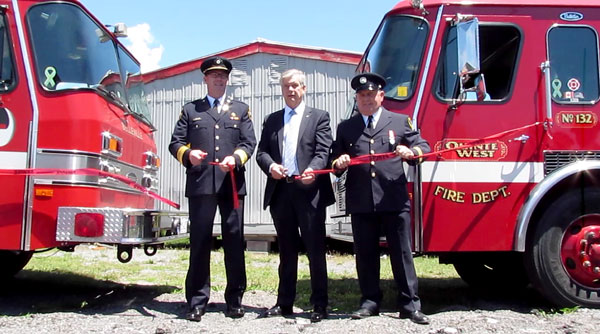Mutual fire aid training complex now official campus of Ontario Fire College
Sue Capon | Jul 10, 2014 | Comments 0

The location of a munitions factory explosion that threatened to destroy Trenton almost 100 years ago, is now the site of a training complex that saves lives.
On Thursday, firefighters and supporters celebrated the grand re-opening of the Hastings and Prince Edward Counties Mutual Fire Aid Association as an official campus of the Ontario Fire College. The facility, on Chester Road in Trenton, is used by 17 member fire departments, including Prince Edward County’s.
On Thanksgiving weekend in 1918, the British Chemical Company munitions factory exploded and the flames roared across Bunker Hill producing toxic plumes of sulphuric acid, nitric acid, and TNT among other chemicals. Reports of the day indicate there were no fatalities. Residents of Trenton fled as the flames devoured the many buildings at the factory. Eva Curtis became the first women in Canada to receive the Order of the British Empire for her dedication to her job as a switchboard operator. She refused to leave her post and continued to answer calls as the buildings burned around her.
“It’s ironic the site now helps save lives,” said Chuck Naphan, Mutual Aid president, at the official opening on Thursday. Today it will also help hundreds of firefighters across the region, and Ontario, to save lives.”
It is the only training facility in eastern Ontario, the closest being the fire college in Gravenhurst. The site includes a training tower, maze building and garage, classroom and washrooms. Without the complex, firefighters would have to train at the Ontario Fire College in Gravenhurst – a costly option for municipalities and one that the college is not equipped to handle.
Ontario Fire Marshal Ted Wieclawek said the site is a model for others in the province to follow.
“It’s not a secret that all mutual aid associations have a strong relationship between fire chiefs, fire management and the firefighters as well as with the community and community officials,” he said. “But this is a model for collaboration and co-operation in the spirit of providing training so at the end of the day we can all live and work in a safer community.”
Firefighter training focuses on live fires, protective clothing, incident management, self-contained breathing apparatus, fire suppression techniques, ladders, ventilation, survival and search and rescue. New associations at the complex have been created with police, EMS and the military to provide expert training and education to those who protect others. It is also used by industrial emergency crews, municipal employees and firefighters from outside the area attending courses.
The non-profit organization is continuing to fund-raise, notes the County’s Deputy Fire Chief Robert Rutter, who is chairman for the complex’s training course and register. Expansion at the site will include the construction of a 5,000 square-foot three-bay garage and new classrooms.
Two County firefighters – Jim Young and Bob Downey – have earned certifications necessary to teach at the provincial level.
“It’s a fantastic facility,” said PEC Fire Chief Scott Manlow after the ribbon cutting. “It is a great place for the firefighters to access training without having to travel away. And they have all they need here. It’s a world-class training facility.”
During training at the facility, (see video below), fires are set in giant cylinders and fed by straw, to simulate thermal layering and temperatures can reach 1200 degrees Farenheit.
The Maze House is a series of “real situation” tests. The small building contains obstacles including a small entry way where the firefighter must remove their air pack, but leave their face mask on as they crawl on their stomach and push the breathing apparatus in front of them, through the entry, then crawl through themselves and put the air pack back on. It sounds straight forward, but keep in mind, the firefighters must do this without vision – a situation they would encounter in many fires. In darkness, they also learn how to feel their way around to identify markings on the water hoses to constantly be aware of which direction exits the building.
Simulating an attic space or a ceiling that has fallen in, firefighters must also learn how to safely navigate entanglements of unknown wiring. With advances in technology there is more wiring in buildings than ever before. The technique is used mostly in office settings.
Filed Under: Featured Articles
About the Author:


































